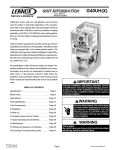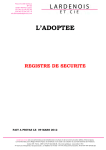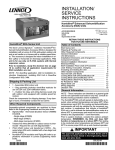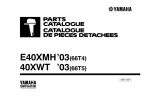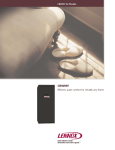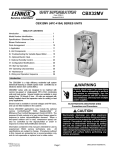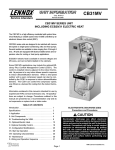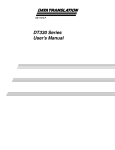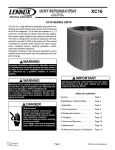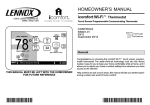Download Lennox International Inc. Water Heater AIR HANDLERS User's Manual
Transcript
INSTALLATION INSTRUCTIONS E2006 Lennox Industries Inc. Dallas, Texas, USA CBWMV Series Units AIR HANDLERS 505,047M 09/06 Supersedes 02/06 Litho U.S.A. Table of Contents Introduction . . . . . . . . . . . . . . . . . . . . . . . . . . . . . . . . . . . Shipping & Packing List . . . . . . . . . . . . . . . . . . . . . . . . CBWMV Unit Dimensions . . . . . . . . . . . . . . . . . . . . . . General . . . . . . . . . . . . . . . . . . . . . . . . . . . . . . . . . . . . . . CBWMV Unit Parts Arrangement . . . . . . . . . . . . . . . . CBWMV Unit Parts Description . . . . . . . . . . . . . . . . . . CBWMV Unit Optional Accessories . . . . . . . . . . . . . . Requirements . . . . . . . . . . . . . . . . . . . . . . . . . . . . . . . . . Application . . . . . . . . . . . . . . . . . . . . . . . . . . . . . . . . . . . Installation − Setting Equipment . . . . . . . . . . . . . . . . . . Duct System . . . . . . . . . . . . . . . . . . . . . . . . . . . . . . . . . . Return Air Opening Guidelines . . . . . . . . . . . . . . . . . . Filter Assembly & Filters . . . . . . . . . . . . . . . . . . . . . . . Plumbing . . . . . . . . . . . . . . . . . . . . . . . . . . . . . . . . . . . . . Electrical . . . . . . . . . . . . . . . . . . . . . . . . . . . . . . . . . . . . . Freezestat Operation . . . . . . . . . . . . . . . . . . . . . . . . . . BDC3 Variable Blower Control Board . . . . . . . . . . . . . Blower Speed Adjustments . . . . . . . . . . . . . . . . . . . . . Initial Air System Purging . . . . . . . . . . . . . . . . . . . . . . . System Adjustments . . . . . . . . . . . . . . . . . . . . . . . . . . . Annual Service . . . . . . . . . . . . . . . . . . . . . . . . . . . . . . . . Service Filters . . . . . . . . . . . . . . . . . . . . . . . . . . . . . . . . Winterizing the CBWMV Unit . . . . . . . . . . . . . . . . . . . . Repair Parts List . . . . . . . . . . . . . . . . . . . . . . . . . . . . . . Troubleshooting: Continuous Fan Sequence of Operation . . . . . . . . . . Cooling Sequence of Operation . . . . . . . . . . . . . . . . . Heating Sequence of Operation . . . . . . . . . . . . . . . . . RETAIN THESE INSTRUCTIONS FOR FUTURE REFERENCE WARNING Due to higher operating pressures, CBWMV units must not be applied to steam boiler systems. CAUTION Unit is designed to be used with non−potable boiler systems only. 1 − CBWMV Air Handler [NOTE − Includes freezestat mounted to the manifold.] Physical contact with metal edges and corners while applying excessive force or rapid motion can result in personal injury. Be aware of, and use caution when working near these areas during installation or while servicing this equipment. 1 − Bag assembly containing: Introduction The multi−positional Dave Lennox Signaturet Collection CBWMV air handler/hot water coil unit is designed to be used with non-potable boiler systems for warm air heating. A variety of Lennox air conditioning systems may be applied to the CBWMV unit for optional cooling. *2P0906* 18 19 20 Shipping & Packing List CAUTION 09/06 1 1 2 3 3 3 3 4 4 4 5 6 8 8 8 12 12 12 16 17 17 17 17 17 1 − Electrical make−up box 1 − Copper fitting 1 − Snap bushing 2 − Water line grommets 3 − Wire nuts 2−7/8" cabinet plugs Check equipment for shipping damage. If you find any damage, immediately contact the last carrier. Page 1 505,047M *P505047M* CBWMV Unit Dimensions − inches (mm) *NOTE − Single side inlet applications result in approximately 4 percent reduction of CFM on B−size units and approximately 5 percent reduction of CFM on C−size units. WATER INLET G SUPPLY AIR OPENING F WATER OUTLET E D 23-3/4 (603) OPTIONAL EXTERNAL SIDE RETURN AIR FILTER KIT (Either Side) − Not for use with optional Return Air Base. 25 (635) TOP VIEW 28−1/2 (724) A 9/16 (14) B 9/16 (14) 19−7/16 (494) ALTERNATE WATER INLET (far side) 1−1/4" (32) 10−1/2" (267) 1−3/4" (44) ALTERNATE WATER OUTLET OPTIONAL EXTERNAL SIDE RETURN AIR FILTER KIT (Either Side) 2" (51) ELECTRICAL INLET (Either Side) 40 (1016) 4 (102) 14−3/4 (375) 16 (406) 23 (584) *OPTIONAL RETURN CUTOUT (Either Side) 14 (356) AIR FLOW 1−15/16 (49) 5/8 (16) C 3/4 (19) *Bottom Return Air Opening FRONT VIEW CBWMV Model No. −24B−040 −36B−070 −36C−090 −60C−100 −60C−120 23−1/2 (597) 4−1/4 (108) 3/4 (19) A B 17−1/2 (445) 16−3/8 (416) 21 (533) SIDE VIEW C D E F G 16 (406) 1−1/2 (38) 1−3/4 (44) 8 (203) 2 (51) 2 (51) 2−1/2 (64) 9−1/2 (241) 1−1/2 (38) 19−7/8 (454) 19−1/2 (495) Page 2 505047 09/06 *Bottom Return Air Opening General CBWMV Unit Parts Description These instructions are intended as a general guide and do not supersede local codes in any way. Consult authorities having jurisdiction before installation. Only qualified service technicians or installers may install and service this unit. CBWMV Unit Parts Arrangement CBWMV Unit HOT WATER COPPER TUBE COIL INSULATED STEEL CABINET Blower The CBWMV is equipped with a variable speed motor that provides separate cooling and heating CFM selections and low continuous fan speeds. Hot Water Coil The copper tube coil is equipped with aluminum fins which provide excellent heat transfer. Manual air bleed ports are located in the copper tubing to release trapped air in the water circuit in all unit configurations. Blower Control The control provides a fixed blower delay of 45 seconds ON / 30 seconds OFF on a W call. Thermostat and accessory connections are made to the terminal strips in the control box. CBWMV Unit Optional Accessories Accessory Circulators (53J76, 99K69) An accessory circulator should be used in long line applications. Two circulators are available with either 9 gallons per minute (99K69) or 14 gpm (53J76) flow rate. Both units have 7/8" soldering joints (inlet and outlet) . See piping section for more information. Downflow Base (68M03) A downflow base kit is available for downflow applications without add−on cooling coils. The base provides clearance for routing the CBWMV unit’s inlet and outlet water lines. SUPPLY AIR BLOWER CBWMV CONTROL BOX NOTE − Downflow applications with an add−on cooling coil require field−fabricated transitions to provide adequate clearance for servicing/removing the cooling coil without cutting the water lines. Figure 1 Page 3 CBWMV SERIES Requirements Application The CBWMV unit is designed for use in non−potable water boiler systems. The water heating device must be adequate to provide enough heat according to the Engineering Handbook specifications. The water heating device must provide a minimum of 6 gallons/minute for small units (CBWMV−040, −070) and 9 gallons/minute for large units (CBWMV−090, −100, −120). WARNING Improper installation, adjustment, alteration, service or maintenance can cause personal injury, loss of life, or damage to property. Installation and service must be performed by a qualified installer or service agency. Installation − Setting Equipment Installation of Lennox CBWMV unit must conform with local building codes. Refer to the electrical section (Page 8) for US and Canadian electrical regulations. When paired with a water heating device, refer to local building codes for special considerations. Refer to water heating device for agency and service clearances. Clearances to combustibles for the CBWMV unit only is zero inches on all sides. Table 1 lists recommended service clearances. WARNING This product contains fiberglass wool. Disturbing the insulation during installation, maintenance, or repair will expose you to fiberglass wool dust. Breathing this may cause lung cancer. (Fiberglass wool is known to the State of California to cause cancer.) Fiberglass wool may also cause respiratory, skin, and eye irritation. Table 1 CBWMV Unit Service Clearances Clearances Location Inches (mm) Recommended Service Access Front Access Panel 30 (762) To reduce exposure to this substance or for further information, consult material safety data sheets available from address shown below, or contact your supervisor. NOTE − Service access clearance must be maintained. Accessibility and service clearances must take precedence over fire protection clearances. For installation in a residential garage, unit must be located or protected to avoid physical damage by vehicles. The CBWMV unit must be installed so that its electrical components are protected from water. When the CBWMV unit is used with an air conditioner, the air handler shall be installed on the upstream side of the cooling evaporator coil to avoid freeze−up of water system and condensation. With a parallel flow arrangement, a damper (or other means to control the flow of air) must adequately prevent chilled air from entering the air handler. If the damper is manually operated, it must be equipped to prevent operation of either the heating or the cooling unit, unless it is in the full HEAT or COOL setting. NOTE − CBWMV series units must not be used in or for the following applications: S construction heater − during any phase of construction S unit heater S mobile home heater S potable water applications Lennox Industries Inc. P.O. Box 799900 Dallas, TX 75379−9900 The boiler installation must conform to the requirements of the authority having jurisdiction or, in the absence of such requirements, to the latest revision of the National Fuel Gas Code, ANSI Z223. (Available from the American Gas Association, 8501 E. Pleasant Valley Road, Cleveland, OH 44134). Reference should also be made to local gas utility regulations and other codes in effect in the same area in which the installation is to be made. When installed in Canada: The latest revision of the CAN1/CSA−B149.1 and/or B149.2 Installation Codes for Gas-Burning Equipment and/or local codes. Determine the CBWMV unit installation location and position units so that door panels are accessible. Keep in mind routing of the water and plumbing lines and electrical connections. The CBWMV unit is multi−positional. No adjustment is necessary to apply unit for upflow or horizontal discharge. A downflow base is available and provides clearance for routing the inlet/outlet water lines when the CBWMV unit is applied without an add−on cooling coil. Downflow applica- Page 4 505047 09/06 tions with add−on cooling coils require field−fabricated transitions that provide at least 6 inches of clearance for the CBWMV unit’s inlet/outlet water lines. See figure 2 for examples. Either suspend the unit from the roof rafters or floor joists or mount on a platform. The CBWMV unit must be level and well supported. NOTE − 1/2 hp and 1 hp blower motors are equipped with three flexible legs and one rigid leg. The rigid leg is equipped with a shipping bolt and a flat white plastic washer (rather than the rubber mounting grommet used with a flexible mounting leg). The bolt and washer must be removed before the air handler is placed into operation. After the bolt and washer have been removed, the rigid leg will not touch the blower housing. CBWMV Multi−Positional Unit AIR FLOW RIGHT HAND DISCHARGE* AIR FLOW Duct System AIR FLOW Use industry-approved standards (such as those published by Air Conditioning Contractors of America or American Society of Heating, Refrigerating and Air Conditioning Engineers) to size and install the supply and return air duct system. This will result in a quiet and low-static system that has uniform air distribution. UPFLOW DOWNFLOW BASE AIR FLOW NOTE − Do not operate the air handler with an external static pressure that exceeds 0.8 inches w.c. Higher external static pressures may cause erratic operation. LEFT HAND DISCHARGE* DOWNFLOW * CBWMV units must not be installed horizontally on the front or back of the unit. Return Air Plenum Figure 2 Units may be horizontally installed in either attic or crawl space. IMPORTANT CAUTION CBWMV series units are shipped with an antifreeze thermostat to prevent the water coil from freezing. The freezestat is installed at the factory but must be field wired (see figures 12 and 13). Do not bypass this feature when you install or run the unit. CAUTION Use a drain pan for installations over finished living areas. Return air must not be drawn from a room where any fossil fuel appliance (ie., a water heater) is installed. When return air is drawn from a room, a negative pressure is created in the room. If a fossil fuel appliance is operating in a room with negative pressure, the flue products can be pulled back down the vent pipe and into the room. This reverse flow of the flue gas may result in incomplete combustion and the formation of carbon monoxide gas. This toxic gas might then be distributed throughout the house by the air handler duct system. Page 5 CBWMV SERIES Side Return Air With Transition And Filter Return Air Opening Guidelines NOTE − Do not bring in air from the back of the unit. Return air can be brought in from the sides or bottom only. 20" X 25" X 1" (508MM X 635MM X 25MM) CLEANABLE FILTER Bottom Return If the air handler is installed on a platform with bottom return, make an airtight seal between the bottom of the air handler and the platform to ensure that the air handler operates properly and safely. Use aluminum tape or mastic between the plenum and the air handler cabinet to ensure a tight seal. The air handler is equipped with a removable bottom panel to facilitate installation. RETURN AIR PLENUM TRANSITION Figure 3 Side Return For side return air applications, cut the air handler cabinet at the maximum return air dimensions shown on page 2. See figure 3 for a typical side inlet arrangement with a transition and filter. Return Air Base NOTE − Single side inlet applications result in approximately a 4 percent reduction of CFM on B−size units and approximately a 5 percent reduction of CFM on C−size units: *NOTE − Both unit and return air base openings must be connected to and entirely covered by a single plenum or IAQ accessory opening. Optional side return air filter kits cannot be used with RAB Return Air Base. For return air with the optional return air base (RAB), see figure 4 (and refer to installation instructions provided with Return Air Base kit). Optional Return Air Base and Unit Dimensions − Inches (mm) 4 (102) *23 (584) Overall (Max.) NOTE − IN SIDE RETURN APPLICATIONS, THE RAB IS REQUIRED FOR 100% CFM CAPACITY. 17 (432) RAB−B (98M60) 21 (533) RAB−C (98M58) *Unit Opening Side Return Air Openings (Either Side) AIR FLOW RETURN AIR BASE *Minimum 11 (279) *Maximum 14 (356) 7−1/4 (184) *Base Opening 23 (584) 27−5/8 (702) 7/8 (22) FRONT VIEW SIDE VIEW Figure 4 Page 6 505047 09/06 *Height varies with plenum or IAQ accessory height. 5−5/8 (143) 3/4 (19) through the bottom panel and the bottom flange of the cabinet. 2. Install one bolt and two nuts into each hole. Screw the first nut onto a bolt and then insert the bolt into a hole. A flat washer may be added between the nut and the bottom of the unit. 3. Screw another nut onto the bolt on the inside of the air handler base. A flat washer may be added between the nut and the bottom of the unit. 4. Adjust the outside nut to the appropriate height and tighten the inside nut to secure the arrangement. Removing the Bottom Panel (bottom return or return air base configurations)Remove the two screws that secure the bottom cap to the air handler. Pivot the bottom cap down to release the bottom panel. Once the bottom panel has been removed, reinstall the bottom cap. See figure 5. Removing the Bottom Panel Horizontal Applications The CBWMV air handler can be installed in horizontal applications. Refer to Engineering Handbook for additional information. Allow for clearances to combustible materials as indicated on the unit nameplate. This air handler may be installed in either an attic or a crawlspace. Either suspend the air handler from roof rafters or floor joists, as shown in figure 7. The unit must be supported at both ends and beneath the blower deck to prevent sagging. BOTTOM CAP SCREW BOTTOM PANEL Unit Suspended in Attic or Crawlspace Figure 5 Leveling an Upflow UnitWhen the side return air inlets are used in an upflow application, it may be necessary to install leveling bolts on the bottom of the air handler. Use field−supplied corrosion−resistant 5/16 inch machine bolts (4) and nuts (8). See figure 6. 1/4 IN. RODS DRAIN PAN NOTE − Maximum leveling bolt length is 1−1/2 inches. ALLOW SUFFICIENT CLEARANCE BETWEEN ROD AND UNIT TO REMOVE ACCESS PANEL. Leveling Bolt Installation 3/8 (10) inches (mm) AIR HANDLER FRONT 1−3/4 (44) 3/8 (10) ANGLE IRON U−CHANNELS Figure 7 1−3/4 (44) LEVELING BOLT LOCATIONS AIR HANDLER BOTTOM NOTE − Heavy−gauge, perforated sheet metal straps (plumbers’ straps) may be used to suspend the unit from roof rafters or ceiling joists. When suspending the unit in this manner, support must be provided for both the ends and the middle of the air handler to prevent sagging. Straps must not interfere with plenum or water piping. Securing screws should be 1/2 inch from the top edge and 1−1/2 inch from the side edge in all cases. Cooling coils and supply and return air plenums must be supported separately. NOTE − When the air handler is installed on a platform in a crawlspace, it must be elevated enough to avoid water damage and to allow the optional evaporator coil to drain. LEVELING BOLT LOCATIONS 3/8 (10) 3/8 (10) 1−3/4 (44) 1−3/4 (44) Horizontal and Downflow Applications Figure 6 1. Lay the air handler on its back and drill a 5/16 inch diameter hole in each corner of the air handler’s bottom. See figure 6 for the correct location of the holes. Drill Return air can be brought in through the end of an air handler installed in the horizontal or downflow application. The air handler is equipped with a removable bottom panel to facilitate installation (see figure 5). Page 7 CBWMV SERIES Refer to figure 12 for schematic wiring diagram and troubleshooting. Filter Assembly & Filters This unit is not equipped with a filter or rack. A field−provided high−velocity filter is required for the unit to operate properly. Table 2 lists recommended filter sizes. A filter must be in place any time the unit is operating. Table 2 Recommended Filter Sizes Air Handler Cabinet Size 17−1/2" 21" Filter Size Side Return Bottom Return 16 X 25 X 1 (1) 16 X 25 X 1 (1) 16 X 25 X 1 (1) 20 X 25 X 1 (1) Line Voltage (120V) Line voltage field supply conductors are terminated at the CBWMV unit. The unit is shipped with the line voltage connections secured to the lower left coil manifold for left side make−up box installations. For right side make−up box installations, remove the wire tie that holds the line voltage connections and pull excess wires into blower deck/control box area as shown in figure 8. Install make−up box (provided for line voltage wiring in the unit’s bag assembly) as shown in figure 9. Make−up Box Wiring Plumbing Pipe and Fitting Specifications Refer to local building and plumbing codes for approved copper pipe and fittings. Plumbing Procedures Refer to the installation instructions of the water heating device to be used with the CBWMV unit. Follow the recommendations outlined in that instruction as well as governing plumbing codes and practices. Plumbing Checklist S Flush water lines between the CBWMV unit and the S WIRES SHOWN AS SHIPPED, ROUTED FOR LEFT SIDE MAKE−UP BOX INSTALLATION FOR RIGHT SIDE MAKE−UP BOX INSTALLATION REMOVE WIRE TIE, PULL EXCESS WIRE INTO BLOWER DECK / CONTROL BOX AREA. water heating device before start−up. Normal flushing procedures should be used to rid the system of contaminants and foreign debris. CBWMV units are installed in non-potable systems. Electrical Wiring and grounding must conform to the current National Electric Code ANSI/NFPA No. 70, or Canadian Electric Code Part I, CSA Standard C22.1, and local building codes. Refer to following wiring diagrams. See unit nameplate for minimum circuit ampacity and maximum overcurrent protection size. Select the proper supply circuit conductors in accordance with tables 310−16 and 310−17 in the National Electric Code, ANSI/NFPA No. 70 or tables 1 through 4 in the Canadian Electric Code, Part I, CSA Standard C22.1. Figure 8 Interior Make−Up Box Installation MAKE−UP BOX MAKE−UP BOX CAUTION USE COPPER CONDUCTORS ONLY. WARNING Electric shock hazard. Can cause injury or death. Before attempting to perform any service or maintenance, turn the electrical power to unit OFF at disconnect switch(es). Unit may have multiple power supplies. LEFT SIDE Figure 9 Page 8 505047 09/06 RIGHT SIDE National Electric Code (ANSI/NFPA No. 70) for the USA and current Canadian Electric Code part 1 (CSA standard C22.1) for Canada. A green ground wire is provided in the field make−up box. 5. Install the room thermostat according to the instructions provided with the thermostat. See table 3 for field wiring connections in varying applications. If the air handler is being matched with a heat pump, refer to the FuelMaster21® installation instruction. Electrostatic Discharge (ESD) - Precautions And Procedures CAUTION Electrostatic discharge can affect electronic components. Take precautions during air handler installation and service to protect the air handler’s electronic controls. Precautions will help to avoid control exposure to electrostatic discharge by putting the air handler, the control and the technician at the same electrostatic potential. Neutralize electrostatic charge by touching hand and all tools on an unpainted unit surface, such as the blower deck, before performing any service procedure. Removeable Jumpers Refer to table 3 for field wiring. 1. Refer to the CBWMV unit’s nameplate for minimum circuit ampacity and maximum overcurrent protection size. 2. Install a separate disconnect switch (protected by either fuse or circuit breaker) near the air handler so that power can be turned off for servicing. 3. Complete the wiring connections to the equipment. Use the provided unit wiring diagram and the field wiring diagrams shown in table 3. Use 18−gauge wire or larger that is suitable for Class II rating for thermostat connections. 4. Electrically ground the unit according to local codes or, in the absence of local codes, according to the current Removeable Jumper DS to Y1The factory−installed wire jumper that connects terminals DS and Y1 on the TB1 terminal strip in the control box must be removed when the air handler is installed in a system supporting dehumidification using a SignatureStatt thermostat (e.g., Humiditrol® Enhanced Dehumidification Accessory or Harmonyt zone controls). Removeable Jumper R to OThe factory−installed wire jumper that connects TB7 (24V) terminal R to TB1 terminal O must be removed when the air handler is installed in applications which include a heat pump unit and the FuelMaster21® control board. If the jumper is left intact, terminal O will remain energized, eliminating the heat mode in the heat pump. Removeable Jumper Y1 to Y2The factory−installed wire jumper that connects Y1 and Y2 on the TB1 terminal strip must be removed if two−stage cooling is used. If the jumper is not removed the outdoor unit will only operate in second−stage cooling. Table 3 Field Wiring Application Jumper Settings (See figure 12) Thermostat (Application) 1 Heat / 1 Cool with SignatureStatt Thermostat [Single-Stage Heat Pump] TB1 Y1 to Y2 TB1 DS to Y1 TB1 R to O Yes No (Remove) No (Remove) Wiring Connections SignatureStatt CBWMV OUTDOOR TERMINALS UNIT JUMPERS REMOVED 2 Heat / 2 Cool with SignatureStatt Thermostat [Two-Stage Heat Pump (Refer to FM21 Instructions)] No (Remove) No (Remove) No (Remove) OUTDOOR SignatureStatt CBWMV TERMINALS UNIT ALL JUMPERS REMOVED O" terminal used only with heat pumps. Page 9 CBWMV SERIES Indoor Blower Speeds Accessory Field Wiring (TB66 & TB67) 1. When the thermostat is set to FAN ON," the indoor blower will run continuously at approximately 38% of the second−stage cooling speed when there is no cooling or heating demand. 2. When the CBWMV is in the heating mode, the indoor blower will run on the heating speed designated by the position of the HEAT pin. 3. When there is a cooling demand, the indoor blower will run on the cooling speed designated by the position of the COOL pin. Connect wires from accessories (e.g. powered air cleaners, humidifiers) to terminal blocks TB66 and TB67 (see detail in figure 11). CBWMV Control Box TERMINAL BLOCKS TB2 TB13 (HOT) (NEUTRAL) TRANSFORMER T1 Accessory Field Wiring (K212) Connect field wiring to 3PDT relay K212 (Lennox part 67K66) as shown in figure 10. Accessory Relay Field Wiring (K212) 1 2 3 4 5 6 7 8 9 A CB8 CIRCUIT BREAKER DOOR INTERLOCK SWITCH BDC3 VARIABLE SPEED CONTROL WIRING STRAIN RELIEF BUSHING ACCESSORY FIELD TB66 WIRING TB67 TERMINAL BLOCKS B TERMINAL BLOCK 24V K212 RELAY TERMINAL BLOCK TB1 ACCESSORY RELAY 24V 125MA 1/4" QUICK CONNECT TERMINALS RELAY CONTACTS RATING 8 AMPS @ 120V MAX. 24V COIL Figure 11 Figure 10 Page 10 505047 09/06 Typical CBWMV Wiring Diagram ÉÉ É Figure 12 Page 11 CBWMV SERIES Continuous Low Blower Option Freezestat Operation IMPORTANT Use of the freezestat feature is required in all installations using CBWMV units. The CBWMV unit is equipped with a field-wired freezestat. The freezestat protects the CBWMV system from freezing temperatures when the unit is installed in unconditioned areas. The factory-provided freezestat must energize the circulator when water temperatures fall below 45ºF. Freezestat wiring is shown in figure 13. Refer to the blower speed chart located on the CBWMV unit wiring diagram for factory set cooling, heating and low (continuous) blower speeds. Systems using a cooling thermostat subbase may operate continuous blower (factoryset to operate at 38% of second-stage cooling speed) through the FAN−ON switch of the thermostat. For continuous low blower with a system without a cooling subbase, a fan switching subbase may be used. Heating or cooling demand will cause blower to go to heat or cool speed. Blower Speed Adjustments Diagnostic LEDs RUN LED Indicates a demand for blower operation in either the heating mode or continuous fan−only mode. RUN LED will not illuminate during a cooling demand. CFM LED Indicates the CFM at which the unit is operating. The light flashes once for approximately every 100 CFM. For example, if the unit is operating at 1000 CFM, CFM LED will flash 10 times. If the CFM is 1150, CFM LED will flash 11 full times plus one fast or half flash. At times the light may appear to flicker or glow. This takes place when the control is communicating with the motor between cycles. This is normal operation. The appropriate speed according to application and CFM need is selected by moving jumper pins. Freezestat Field Wiring Figure 13 BDC3 Variable Blower Control Board CBWMV units are equipped with a variable speed motor that is capable of maintaining a specified CFM throughout the external static range. A particular CFM can be obtained by positioning jumpers (COOL, HEAT, and ADJUST) on the BDC3 control board. The COOL and HEAT jumpers are labeled 1, 2, 3, and 4. Each of the numbers corresponds with an air volume (CFM) setting. The ADJUST jumper is labeled TEST, −, +, and NORM. The + and − pin settings are used to add or subtract a percentage of the CFM selected. The TEST jumper is used to operate the motor in the test mode. The DELAY jumper controls ramping profiles. Figure 14 shows the BDC3 control board. Use tables 5 through 9 to determine the correct air volume for heat and cool speed taps. Diagnostic LEDs located on the BDC3 control board are provided to aid in identifying the unit’s mode of operation. Certain scenarios will arise depending on the jumper positions. Read through the jumper settings sections before adjusting blower speed. Refer to figure 14 for identification. Page 12 505047 09/06 BDC3 Variable Speed Control Board JP1 15 PIN PLUG (BOARD TO MOTOR) ACCESSORY RELAY CONTACTS (DRIVES OPTIONAL ACCESSORY RELAY) OPERATIONAL SELECTOR PINS (AFFECTS BOTH HEATING AND COOLING MODES) HEATING SPEED SELECTOR PINS COOLING SPEED SELECTOR PINS FAN DELAY SELECTOR PINS Figure 14 DIAGNOSTIC LEDS Jumper Settings IMPORTANT Before changing jumper setting, make sure the motor has completely stopped. Any jumper setting change will not take place while the motor is running. Table 4 shows the factory blower speed tap settings for CBWMV series units. These settings are for nominal tonnage match−ups with the CBWMV. When matched with other sizes, it is recommended that the CFM be adjusted approximately to 400 CFM per ton. Table 4 Factory Blower Speed Tap Settings CBWMV Blower Coil Cool Pin Heat Pin Adjust Delay −24B−040 −36B−070 −36C−090 −60C−100 −60C−120 1 3 3 4 4 2 4 4 4 4 NORM NORM NORM NORM NORM 4 4 4 4 4 Speed Tap Selection For applications with the Harmony® Zoning System, the blower CFM volume is determined by the Harmony control center. The minimum blower speed is predetermined at 400 CFM for −CBWMV−24B−040 and 36B−070 series units and 600 CFM for CBWMV−36C−090, 60C−100, and 60C−120 series units. This speed is not adjustable. With the thermostat set for Continuous Fan" and without a call for heating or cooling, the CBWMV will provide 38% of the COOL CFM selected. HEAT Pins The HEAT jumper is used to determine CFM heating. These jumper selections are activated only when W1 is energized. (There is a fixed 45 seconds ON and 30 seconds OFF delay on a W call.) DELAY Pins The DELAY jumper is used to set the specific motor fan operation during cooling mode. Depending on the application, one of four options may be chosen by moving the jumper to the appropriate set of pins. #1 Pins Jumpered A Motor runs at 100% until demand is satisfied. A B OFF B To change jumper positions, gently pull the jumper off the pins and place it on the desired set of pins. The following section outlines the different jumper selections available and conditions associated with each one. Refer to figure 14. After the CFM for each application has been determined, the jumper settings must be adjusted to reflect those given in tables 5 through 9. From the tables, determine which row of CFM volumes most closely matches the desired CFM. Once a specific row has been chosen (+, NORMAL, or −), CFM volumes from other rows cannot be used. Below are descriptions of the jumper selections. ADJUST Pins The ADJUST pins allow the motor to run at normal speed, approximately 10% higher, or approximately 10% lower than normal speed. Tables 5 through 9 gives three rows (+, NORMAL, and −) with their respective CFM volumes. Notice that the normal adjustment setting for heat speed position #3 is 1070 CFM. The + adjustment setting for that position is 1180 CFM and for the − adjustment setting is 940 CFM. After the adjustment setting has been determined, chose the remainder speed jumper settings from those offered in the table in that row. The TEST pin is available to bypass the BDC3 control and run the motor at approximately 70% to test that the motor is operational. This is beneficial primarily in troubleshooting. G must be energized for motor to run. COOL Pins The COOL jumper is used to determine the CFM during either 1) cooling or 2) heat pump operation without a W1 call for electric heat. These jumper selections are activated for cooling when Y1 and/or Y2 and DS terminals in the CBWMV unit are energized and for heating when Y1 and/or Y2 is energized. OFF Once demand is met, motor ramps down to stop. #2 Pins Jumpered A Motor runs at 100% until demand is satisfied. B A C OFF OFF B Once demand is met, motor runs at 100% for 45 seconds. Then, C ramps down to stop. NOTE − Blower OFF DELAY also applies during heat pump operation #3 Pins Jumpered A Motor runs at 82% for approximately 7−1/2 minutes. If demand has not been satisfied after 7−1/2 minutes, B motor runs at 100% until demand is satisfied. A B C OFF C OFF Once demand is met, motor ramps down to stop. #4 Pins Jumpered A Motor runs at 50% for 30 seconds. B Motor then runs at 82% for approximately 7−1/2 minutes. If demand has not been satisfied after 7−1/2 minutes. C Motor runs at 100% until demand is satisfied. D Once demand is met, motor runs at 50% for 30 seconds. Then, A B OFF E C D E OFF ramps down to stop. Page 13 CBWMV SERIES Table 5 CBWMV−24B−040 Blower Performance 0 through 0.80 in. w.g. (0 Through 200 Pa) External Static Pressure Range ; Factory Settings: Heating Speed − 2, Cooling Speed − 1, Speed Adjust − NORM; Applications with single sided inlets will reduce CFM by approximately 4%. BDC3 Jumper Speed Positions ADJUST" Jumper Setting 1 L/s 770 365 930 440 700 330 830 390 630 295 750 355 2nd Stage COOL" Speed 2 3 cfm L/s cfm L/s 1010 910 810 475 430 380 cfm L/s + 820 385 990 465 1180 555 1340 630 880 415 1120 530 1340 630 NORM 750 355 900 425 1070 505 1230 580 800 375 1000 470 1200 565 970 315 810 380 940 445 1080 510 720 340 900 425 1080 510 The effect of static pressure and filter resistance is included in air volumes shown. 1st stage COOL is approximately 70% of the same 2nd stage COOL speed position. Continuous Fan Only speed is approximately 38% of the same 2nd stage COOL speed position. Lennox Harmony zone control applications − Minimum blower speed is 400 cfm. Max cfm is the same as 2nd stage cool position. 1440 1300 1170 680 615 550 ADJUST" ADJUST Jumper p S Setting 1 cfm L/s HEAT" Speed 2 3 cfm L/s cfm L/s L/s 610 560 510 290 265 240 4 cfm + NORM cfm 1st Stage COOL" Speed 2 3 cfm L/s cfm L/s 4 cfm 1 L/s cfm L/s 4 Table 6 CBWMV−36B−070 Blower Performance 0 through 0.80 in. w.g. (0 Through 200 Pa) External Static Pressure Range ; Factory Settings: Heating Speed − 4, Cooling Speed − 3, Speed Adjust − NORM; Applications with single sided inlets will reduce CFM by approximately 4%. BDC3 Jumper Speed Positions ADJUST" Jumper Setting 1 + NORM ADJUST" ADJUST Jumper p Setting 1 cfm L/s HEAT" Speed 2 3 cfm L/s cfm L/s cfm L/s 590 545 490 280 255 230 4 cfm 1 L/s cfm L/s 1st Stage COOL" Speed 2 3 cfm L/s cfm L/s 745 350 895 420 680 320 805 380 600 280 725 340 2nd Stage COOL" Speed 2 3 cfm L/s cfm L/s + 790 370 980 465 1140 540 1310 620 850 400 1090 515 1300 620 NORM 730 345 870 410 1040 490 1190 560 775 365 990 465 1190 560 640 300 770 360 920 435 1070 505 700 330 870 410 1065 500 The effect of static pressure and filter resistance is included in air volumes shown. 1st stage COOL is approximately 70% of the same 2nd stage COOL speed position. Continuous Fan Only speed is approximately 38% of the same 2nd stage COOL speed position. Lennox Harmony zone control applications − Minimum blower speed is 400 cfm. Max cfm is the same as 2nd stage cool position. Page 14 505047 09/06 4 cfm L/s 975 890 780 460 420 370 4 cfm L/s 1430 1280 1150 675 605 540 Table 7 CBWMV−36C−090 Blower Performance 0 through 0.80 in. w.g. (0 Through 200 Pa) External Static Pressure Range ; Factory Settings: Heating Speed − 4, Cooling Speed − 3, Speed Adjust − NORM; Applications with single sided inlets will reduce CFM by approximately 5%. BDC3 Jumper Speed Positions ADJUST" Jumper Setting 1 L/s 770 365 930 440 700 330 830 390 630 295 760 360 2nd Stage COOL" Speed 2 3 cfm L/s cfm L/s 1010 910 810 475 430 380 cfm L/s + 820 385 1000 470 1180 555 1340 630 890 420 1130 535 1340 630 NORM 760 360 900 425 1070 505 1220 575 800 380 1020 480 1220 575 675 320 810 380 950 450 1100 520 720 340 900 425 1100 520 The effect of static pressure and filter resistance is included in air volumes shown. 1st stage COOL is approximately 70% of the same 2nd stage COOL speed position. Continuous Fan Only speed is approximately 38% of the same 2nd stage COOL speed position. Lennox Harmony zone control applications − Minimum blower speed is 400 cfm. Max cfm is the same as 2nd stage cool position. 1450 1310 1180 685 620 555 ADJUST" ADJUST Jumper p S Setting 1 cfm L/s HEAT" Speed 2 3 cfm L/s cfm L/s L/s 620 570 520 290 270 245 4 cfm + NORM cfm 1st Stage COOL" Speed 2 3 cfm L/s cfm L/s 4 cfm 1 L/s cfm L/s 4 Table 8 CBWMV−60C−100 Blower Performance 0 through 0.80 in. w.g. (0 Through 200 Pa) External Static Pressure Range ; Factory Settings: Heating Speed − 4, Cooling Speed − 3, Speed Adjust − NORM; Applications with single sided inlets will reduce CFM by approximately 5%. BDC3 Jumper Speed Positions ADJUST" Jumper Setting 1 L/s 1250 590 1380 650 1130 535 1250 590 1040 490 1130 535 2nd Stage COOL" Speed 2 3 cfm L/s cfm L/s 1530 1380 1260 720 650 595 cfm L/s + 1500 710 1700 800 1880 885 2100 990 1540 725 1760 830 1970 930 NORM 1370 645 1540 725 1720 810 1920 905 1400 660 1600 755 1800 850 1250 590 1380 650 1540 725 1720 810 1270 600 1420 670 1600 755 The effect of static pressure and filter resistance is included in air volumes shown. 1st stage COOL is approximately 70% of the same 2nd stage COOL speed position. Continuous Fan Only speed is approximately 38% of the same 2nd stage COOL speed position. Lennox Harmony zone control applications − Minimum blower speed is 600 cfm. Max cfm is the same as 2nd stage cool position. 2200 1980 1780 1040 935 840 ADJUST" ADJUST Jumper p Setting 1 cfm L/s HEAT" Speed 2 3 cfm L/s cfm L/s L/s 1110 1000 930 525 470 440 4 cfm + NORM cfm 1st Stage COOL" Speed 2 3 cfm L/s cfm L/s 4 cfm 1 L/s cfm L/s 4 Page 15 CBWMV SERIES Table 9 CBWMV−60C−120 Blower Performance 0 through 0.80 in. w.g. (0 Through 200 Pa) External Static Pressure Range ; Factory Settings: Heating Speed − 4, Cooling Speed − 4, Speed Adjust − NORM; Applications with single sided inlets will reduce CFM by approximately 5%. BDC3 Jumper Speed Positions ADJUST" Jumper Setting 1 L/s 1250 590 1400 660 1130 535 1260 595 1020 480 1130 535 2nd Stage COOL" Speed 2 3 cfm L/s cfm L/s 1560 1400 1260 735 660 595 cfm L/s + 1510 715 1720 810 1900 895 2120 1000 1570 740 1800 850 2000 945 NORM 1380 650 1560 135 1740 820 1920 905 1410 665 1620 765 1820 860 1240 585 1380 650 1540 725 1720 810 1260 595 1440 680 1620 765 The effect of static pressure and filter resistance is included in air volumes shown. 1st stage COOL is approximately 70% of the same 2nd stage COOL speed position. Continuous Fan Only speed is approximately 38% of the same 2nd stage COOL speed position. Lennox Harmony zone control applications − Minimum blower speed is 600 cfm. Max cfm is the same as 2nd stage cool position. 2200 2020 1810 1040 955 855 ADJUST" ADJUST Jumper p S Setting 1 cfm L/s HEAT" Speed 2 3 cfm L/s cfm L/s L/s 1100 990 930 520 465 440 4 cfm + NORM cfm 1st Stage COOL" Speed 2 3 cfm L/s cfm L/s 4 cfm 1 L/s Initial Air Purging cfm L/s Air Bleed Valve Location After all plumbing connections have been made, leak tested and flushed, the water heating device is ready to be filled with water and purged of air. Air bleeder valves are provided as a convenience for installations that are not equipped with purge manifolds. 1. Make sure electrical power and gas supply to system are OFF. 2. Remove CBWMV coil section access panel. 3. Remove cap from highest air bleed valve and depress valve stem until water is released. This may be done with a refrigerant style hose. See figure 15. VALVE SHOWN WITH CAP ON 4. Replace cap on valve and access panel. 5. Apply electrical power and gas supply to the system. 6. Follow the System Start−Up section to operate the system. Complete purging of air after unit has gone through initial start−up. Page 16 505047 09/06 Figure 15 4 2. Motors are pre−lubricated for extended life; no further lubrication is required. System Adjustments Timed−ON and Timed−OFF Delays Freezestat The 45−second timed−ON delay and the 30−second timed− OFF delay for heating (time that the blower operates after the heat demand has been satisfied) is not adjustable. Verify that the freezestat functions. Blower Speeds Select the blower speed by moving the pins on the variable speed control board. See figure 14. Refer to the speed selection chart on unit wiring diagram. NOTE − To check for proper CFM, take the reading external to the unit. The coil must be dry when you take the reading. Service Filters Filters must be cleaned or replaced when dirty to assure proper unit operation. Winterizing CBWMV Water Coil If unit is installed in an unconditioned space, the piping between the CBWMV unit and the water heating device should be insulated. If power is removed from the unit, water must be drained from the system to prevent freezing. Repair Parts List Annual Service The following repair parts are available. When ordering parts, include the complete unit model number listed on the unit rating plate of each piece of equipment. WARNING Electric shock hazard. Can cause injury or death. Before attempting to perform any service or maintenance, turn the electrical power to unit OFF at disconnect switch(es). Unit may have multiple power supplies. At the beginning of each heating season, system should be checked as follows by a qualified service technician: Electrical 1. Check all wiring for loose connections. 2. Check for correct voltage at CBWMV unit (unit operating). 3. Check to see that blower is operating. Blower 1. Check and clean blower wheel. Cabinet Parts S Blower Access Panel S Coil Access Panel Hot Water Coil Parts S Coil Replacement Kit Blower Part S Blower Wheel S Blower Motor S Blower Housing Electrical Parts S BDC3 Board S Transformer S Circuit Breaker, 24VAC S 3PDT Relay Page 17 CBWMV SERIES WARNING WARNING TO SERVICE PERSONS! Electric shock hazard. When electrical power to the internal control box components must be available for troubleshooting, a common practice is to construct a by−pass" of the door interlock switch. When such a by−pass is in place, a potential shock hazard is present which can cause injury or death. Make sure any door interlock switch by−pass has been removed after troubleshooting is complete and BEFORE attempting any repairs to the control box components! Troubleshooting: Continuous Fan Sequence of Operation CONDITIONS: Power On Normal Operation LED: Steady Flash Thermostat (S1) Calls for Continuous Fan, G−Only NO Check for 24 Volts Between ’G’ and C at A15 Terminal Strip YES Blower Operates at the Continuous Fan Speed Selected by COOL Jumper and ADJUST Jumper Positions on the BDC3 Control (A52) NO Check for 24 Volts Between Pins 3 and 15 on J49 YES RUN Light on BDC3 Control (A52) illuminates to Indicate a Continuous Fan Call YES CFM Light on A52 Indicates Blower CFM Selection with 100CFM / Blink YES Thermostat (S1) Continuous Fan Demand Satisfied YES Blower Off Page 18 505047 09/06 WARNING WARNING TO SERVICE PERSONS! Electric shock hazard. When electrical power to the internal control box components must be available for troubleshooting, a common practice is to construct a by−pass" of the door interlock switch. When such a by−pass is in place, a potential shock hazard is present which can cause injury or death. Make sure any door interlock switch by−pass has been removed after troubleshooting is complete and BEFORE attempting any repairs to the control box components! Troubleshooting: Cooling Sequence of Operation CONDITIONS: Power On Normal Operation LED: Steady Flash Thermostat (S1) Provides 24 Volt Cooling Call to Indoor Blower (B3) NO YES 2 Stage Condensing Unit? NO YES Check for 24 Volts Between Y and C at A15 Terminal Strip Blower (B3) Operates at the 2nd Stage Cooling Speed Determined by COOL, DELAY and ADJUST Jumper Positions on the BDC3 Control (A52) NO Check for 24 Volts Between Pins 14 and 3 on J49 YES Blower (B3) Operates at the 1st Stage Cooling Speed Determined by COOL, DELAY and ADJUST Jumper Positions on the BDC3 Control (A52) CFM Light on A52 Indicates Blower CFM Selection with 100CFM / Blink NO CFM Light on A52 Indicates Blower CFM Selection with 100CFM / Blink YES Thermostat (S1) Demand Satisfied YES YES Check for 24 Volts Between Y and C on A15 Terminal Strip Check for 24 Volts Between Pins 6 and 3 on J49 Blower Shuts Off According to the DELAY Jumper Position on the BDC3 Control (A52) YES Demand for Cooling Satisfied First Stage Demand for Cooling Satisfied? YES Blower Shuts Off According to the DELAY Jumper Position on the BDC3 Control (A52) YES Demand for Cooling Satisfied NO NO Check for 24 Volts Between Y2 on TB1 and C on A15 Terminal Strip NO Blower Operates at the 2nd Stage Cooling Speed Determined by COOL, DELAY and ADJUST Jumper Positions on the BDC3 Control (A52) Check for 24 Volts Between Pins 14 and 3 on J49 Thermostat (S1) Calls for 2nd Stage Cooling YES YES CFM Light on A52 Indicates Blower CFM Selection with 100CFM / Blink YES 2nd Stage Thermostat (S1) Demand Satisfied YES Blower Returns to 1st Stage Cooling Speed Page 19 CBWMV SERIES WARNING WARNING TO SERVICE PERSONS! Electric shock hazard. When electrical power to the internal control box components must be available for troubleshooting, a common practice is to construct a by−pass" of the door interlock switch. When such a by−pass is in place, a potential shock hazard is present which can cause injury or death. Make sure any door interlock switch by−pass has been removed after troubleshooting is complete and BEFORE attempting any repairs to the control box components! Troubleshooting: Heating Sequence of Operation CONDITIONS: Power On Normal Operation LED: Steady Flash Thermostat (S1) Calls for Heat NO Check for 24 Volts Between W and C at A52 Terminal Strip YES Fixed blower−ON delay (45−second) complete Blower Operates at the Heating Speed Selected by HEAT Jumper and ADJUST Jumper Positions on the BDC3 Control (A52) NO YES CFM Light on A52 Indicates Blower Speed Selection with 100CFM / Blink YES Thermostat (S1) Demand Satisfied YES 30 Second Blower Off Delay (Fixed) Complete YES Demand for Heat Satisfied Page 20 505047 09/06 Check for 24 Volts Between Pins 3 and 2 on J49




















